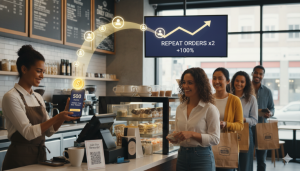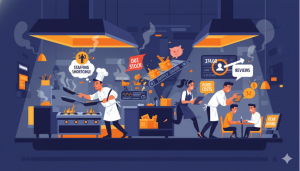In today’s fast-paced world, the food industry is constantly evolving to meet the changing demands of consumers.
With the rise of food delivery apps and the convenience they offer, new concepts like ghost kitchens, cloud kitchens, and virtual restaurants have emerged.
These innovative models have revolutionized the way food businesses operate, but what exactly are they?
In this ultimate guide, we will explore the differences between ghost kitchens, cloud kitchens, and virtual restaurants, and help you understand which model is the right fit for your food business.
What are Ghost Kitchens, Cloud Kitchens, and Virtual Restaurants?
Ghost kitchens, cloud kitchens, and virtual restaurants are all variations of the same concept – they are food businesses that operate without a physical dining space.
Instead, they focus solely on preparing food for delivery or takeout.
While they may have different names, the underlying principle remains the same: to streamline operations and maximize efficiency by eliminating the need for a traditional restaurant setup.
Ghost kitchens, also known as dark kitchens or virtual kitchens, are professional food preparation spaces that are solely dedicated to fulfilling delivery orders.
They often operate out of industrial units or shared kitchen spaces, allowing multiple brands to operate under one roof.
These kitchens eliminate the cost and distractions associated with a dine-in restaurant, allowing businesses to focus solely on preparing high-quality food for delivery.
Cloud kitchens, on the other hand, are similar to ghost kitchens in terms of their operational setup.
These kitchens primarily focus on delivery and takeout but may also offer limited dine-in options.
They are equipped with all the necessary equipment and infrastructure for food preparation, but they may not have a physical storefront or seating area for customers.
Virtual restaurants, also known as delivery-only restaurants or ghost brands, are food establishments that exist solely in the digital realm.
These businesses do not have a physical location and exclusively operate through delivery apps and online platforms.
Virtual restaurants allow entrepreneurs to create new culinary concepts without the upfront costs of setting up a traditional restaurant.
They leverage existing kitchen spaces to bring their unique cuisines directly to customers’ doorsteps.
Ghost kitchens, cloud kitchens, and virtual restaurants have gained significant popularity in recent years, especially with the rise of food delivery services and online ordering platforms.
These concepts have revolutionized the food industry by providing a cost-effective and efficient way for entrepreneurs to enter the market and reach a wider customer base.
Understanding the Concept of Ghost Kitchens
Now that we have a general understanding of what ghost kitchens, cloud kitchens, and virtual restaurants are, let’s dive deeper into the concept of ghost kitchens.
Ghost kitchens have gained tremendous popularity in recent years, primarily due to the explosive growth of food delivery services and the changing preferences of consumers.
These kitchens are designed to be highly efficient and cost-effective, allowing businesses to focus solely on the quality of their food and delivery experience.
One of the key advantages of ghost kitchens is the ability to operate multiple brands under one roof.
As multiple food concepts can share the same kitchen space, businesses have the flexibility to experiment with different menus and cuisines without the need for separate physical locations.
This allows entrepreneurs to optimize their operations and cater to a diverse range of customer preferences, maximizing their revenue potential.
Additionally, ghost kitchens offer significant cost savings compared to traditional restaurants.
By eliminating the costs associated with real estate, interior design, and front-of-house staff, businesses can allocate their resources towards high-quality ingredients, efficient kitchen equipment, and skilled culinary staff.
This ultimately translates to better food quality, faster delivery times, and competitive pricing for customers.
Moreover, the rise of ghost kitchens has been facilitated by advancements in technology and the increasing popularity of online food-ordering platforms.
With the ability to track orders in real-time, manage inventory more efficiently, and leverage data analytics for insights, ghost kitchens have streamlined the entire food preparation and delivery process.
These technological innovations have made it easier than ever for businesses to operate exclusively in the delivery and takeout space.
However, it’s important to note that ghost kitchens are not without their challenges.
One of the main hurdles businesses face is brand recognition.
Without a physical storefront, businesses need to invest heavily in digital marketing and social media to build awareness and attract customers.
Additionally, maintaining consistent quality and delivering hot and fresh food can be a logistical challenge, especially during times of high demand.
Another challenge that ghost kitchens face is the issue of customer experience.
Unlike traditional restaurants, ghost kitchens lack the ambience and atmosphere that dining in a physical establishment provides.
This can impact the overall dining experience for customers, as they miss out on the social aspect of eating out and the personalized service that comes with it.
To overcome this challenge, ghost kitchens need to focus on enhancing the delivery experience by ensuring prompt and efficient service, providing clear communication with customers, and offering attractive packaging that maintains the quality and presentation of the food.
The Rise of Cloud Kitchens in the Food Industry
With the increasing demand for food delivery and the evolving preferences of consumers, cloud kitchens have emerged as a popular alternative to traditional restaurants and ghost kitchens.
These kitchens offer a hybrid approach, providing food businesses with the flexibility to operate both delivery-only and dine-in establishments.
Cloud kitchens typically have a central kitchen that serves as the hub for food preparation and delivery, while also having additional satellite kitchens strategically located in different neighbourhoods to cater to local customer demand.
This decentralized approach allows businesses to minimize delivery distances and offer faster service, ultimately enhancing the overall customer experience.
One of the key advantages of cloud kitchens is their ability to offer limited dine-in options, which can be appealing to customers who prefer the convenience of delivery but still desire the option to eat out occasionally.
By providing a small seating area or partnering with different dining platforms, cloud kitchens can cater to a wide range of customers and adapt to their changing preferences.
Furthermore, cloud kitchens provide businesses with the opportunity to test new concepts and menus without the overhead costs associated with a traditional restaurant.
They offer a more flexible and scalable model, allowing entrepreneurs to pivot and adapt quickly in response to market trends.
This flexibility is particularly valuable in an industry where consumer preferences, dietary trends, and popular cuisines can change rapidly.
However, it’s important to consider the competition within the cloud kitchen space.
With many businesses operating in the same area, it’s essential to differentiate your brand and create a unique dining experience.
Building a strong online presence, partnering with popular delivery apps, and leveraging customer reviews and ratings are crucial strategies for success in the cloud kitchen industry.
Another advantage of cloud kitchens is their potential for cost savings.
By operating in a centralized location and eliminating the need for a physical storefront, businesses can significantly reduce expenses such as rent, utilities, and maintenance.
This cost-effectiveness allows cloud kitchens to offer competitive pricing to customers, making their food more accessible and affordable.
Related Articles:
 Social Media Marketing for Restaurants (New Guide)
Social Media Marketing for Restaurants (New Guide)
 Marketing Restaurant Ideas and Trends For Startups in 2021 (New Guide)
Marketing Restaurant Ideas and Trends For Startups in 2021 (New Guide)
 What is a Point of Sale System and how Does It Work?
What is a Point of Sale System and how Does It Work?
 5 Free & Best Restaurant SEO Tips to Boost Your Online Presence
5 Free & Best Restaurant SEO Tips to Boost Your Online Presence
 Importance Of Restaurant Contactless Delivery & How To Implement It
Importance Of Restaurant Contactless Delivery & How To Implement It







